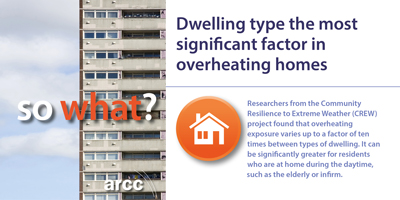Researchers from the Community Resilience to Extreme Weather (CREW) project found that overheating exposure varies up to a factor of ten times between types of dwelling. It can be significantly greater for residents who are at home during the daytime, such as the elderly or infirm.
Climate change projections predict an increase in the frequency and severity of extreme weather events, including heatwaves. By the middle of this century, severe heatwaves similar to that experienced across Europe in August 2003 may occur every year.
Future guidance on the refurbishment of homes therefore must include advice on improvements to provide safe and comfortable dwellings that are adapted to cope with the changing climate as well as reducing energy usage to limit carbon emissions.
Relevance
Refurbishment of homes in the UK has so far focused on reduction of heating energy use and CO2 emissions. However, there is mounting evidence to suggest the need to take into account the comfort of occupants.
Climate change projections predict an increase in both the frequency and severity of extreme weather events, including heatwaves. The European heatwave in August 2003 resulted in the deaths of more than 35,000 people, with over 2,000 fatalities in the UK. Future retrofit planning must therefore take account of winter thermal performance and associated carbon emissions, but also the reduction of summer overheating in order to provide safe and comfortable living environments as the climate changes.
To achieve these goals, detailed quantitative advice is required. The CREW project research builds on previous work by quantifying the effect of a range of single and combined home refurbishment and behavioural interventions during heatwave periods, and by assessing the impact of those interventions on annual heating energy use.
Overheating exposure depends on a range of factors:
- Construction type – occupants of top floor 1960s flats and modern detached houses experience significantly greater overheating exposure than those in solid wall terraced houses, ground floor flats and 1930s semi-detached houses.
- Building orientation – particularly where living rooms and bedrooms have south or west-facing windows.
- Occupancy – residents who are at home during the daytime experience significantly greater overheating exposure, with implications for their health and well-being, in particular for older people.
Now what?
Interventions, in the form of a combination of household behavioural changes and home refurbishment measures, can significantly reduce exposure to overheating whilst also reducing annual heating energy use.
In most cases no single intervention can eliminate overheating and a combination of measures is required. The most effective selection of measures varies, depending on dwelling type, orientation and occupancy profile. Interventions that limit solar gains, such as external window shutters or solar reflective coatings (for older, solid wall properties), are the most effective in reducing overheating.
The Retrofit Toolkit
CREW researchers ran over 180,000 simulations to explore, for standard British house types, the effectiveness of combinations of interventions in both reducing overheating risk and heating energy use.
These have been made into a freely available online toolkit that allows building professionals, decision-makers and homeowners to see the effect of a range of interventions, whilst also providing an estimated cost of adaptation.
No single solution fully addresses the overheating risk. An integrated approach to retrofit is required to ensure that homes are comfortable and safe in a range of weather conditions, particularly for the future climate.
Main messages for home owners & residents
- External window shutters are the single most effective intervention for the majority of cases.
- Simple behavioural measures, such as closing windows during the hottest part of the day and opening them at night, along with closing blinds or curtains during the daytime, can be very effective.
- In some cases, the addition of wall insulation was found to increase overheating exposure, but overheating can still be reduced using other measures.


